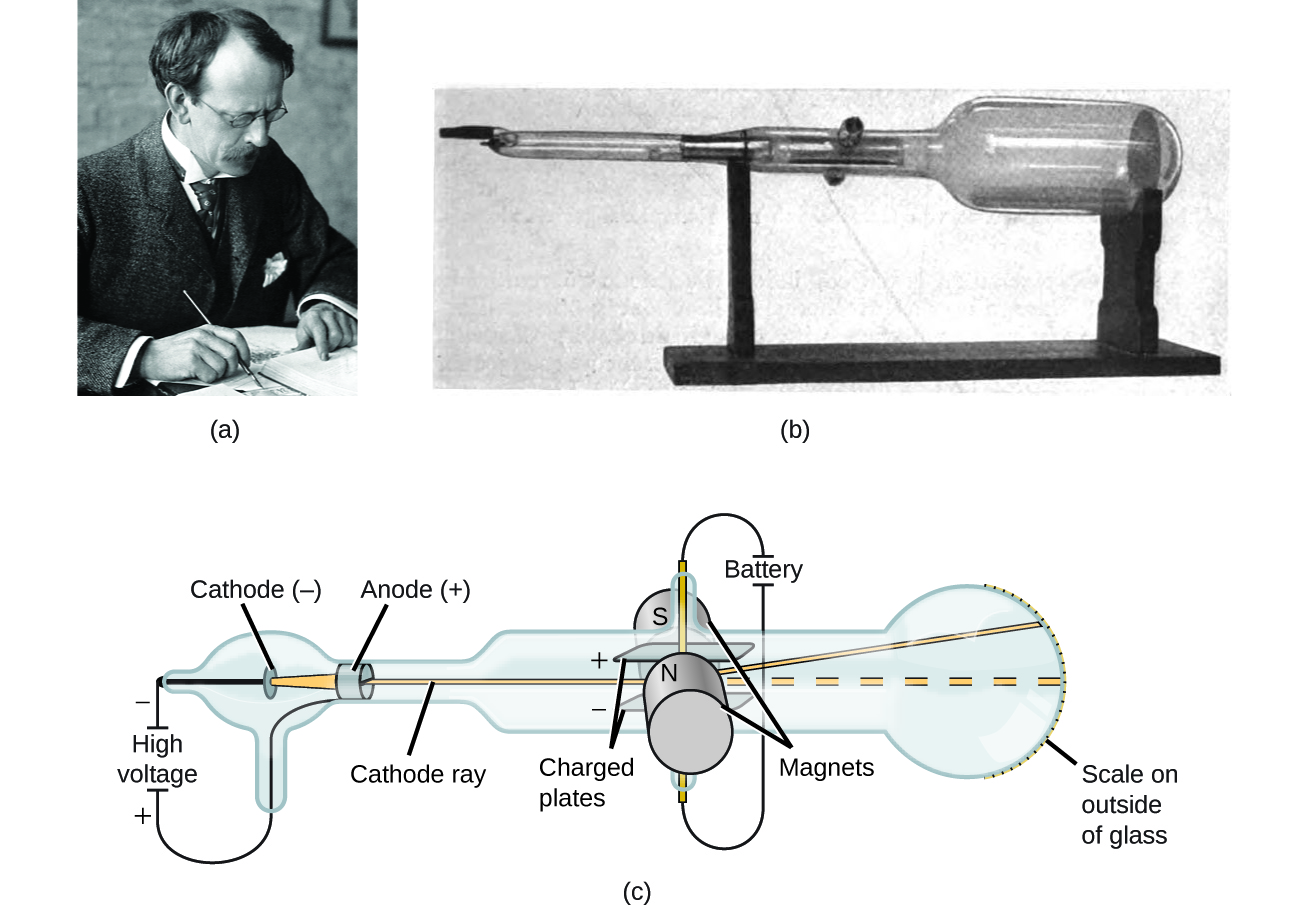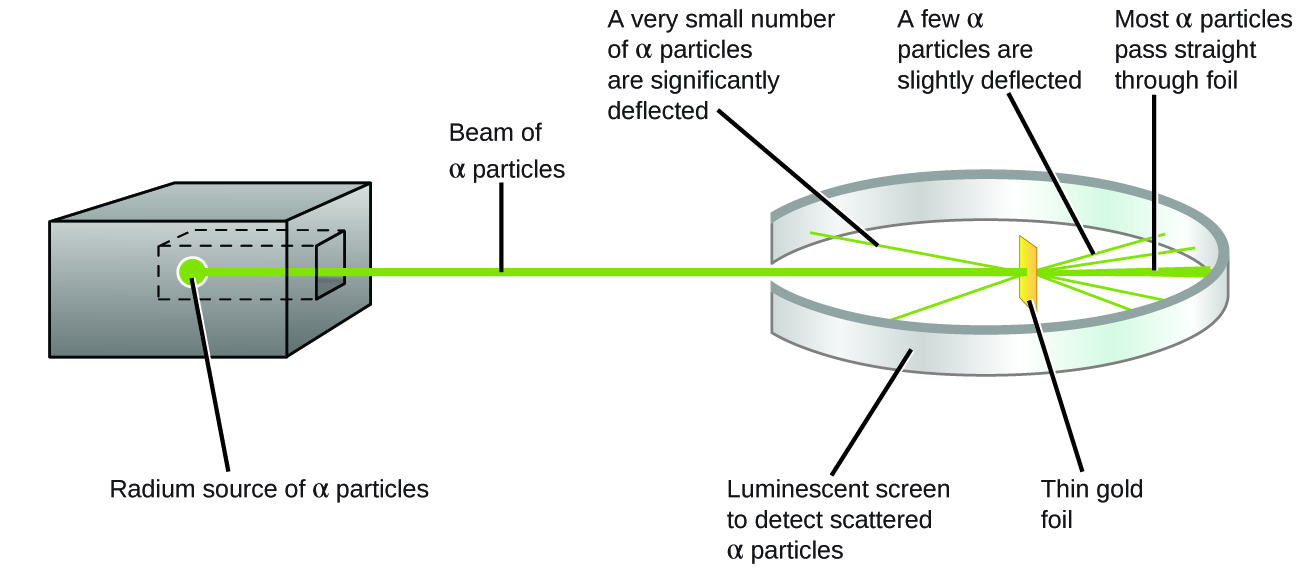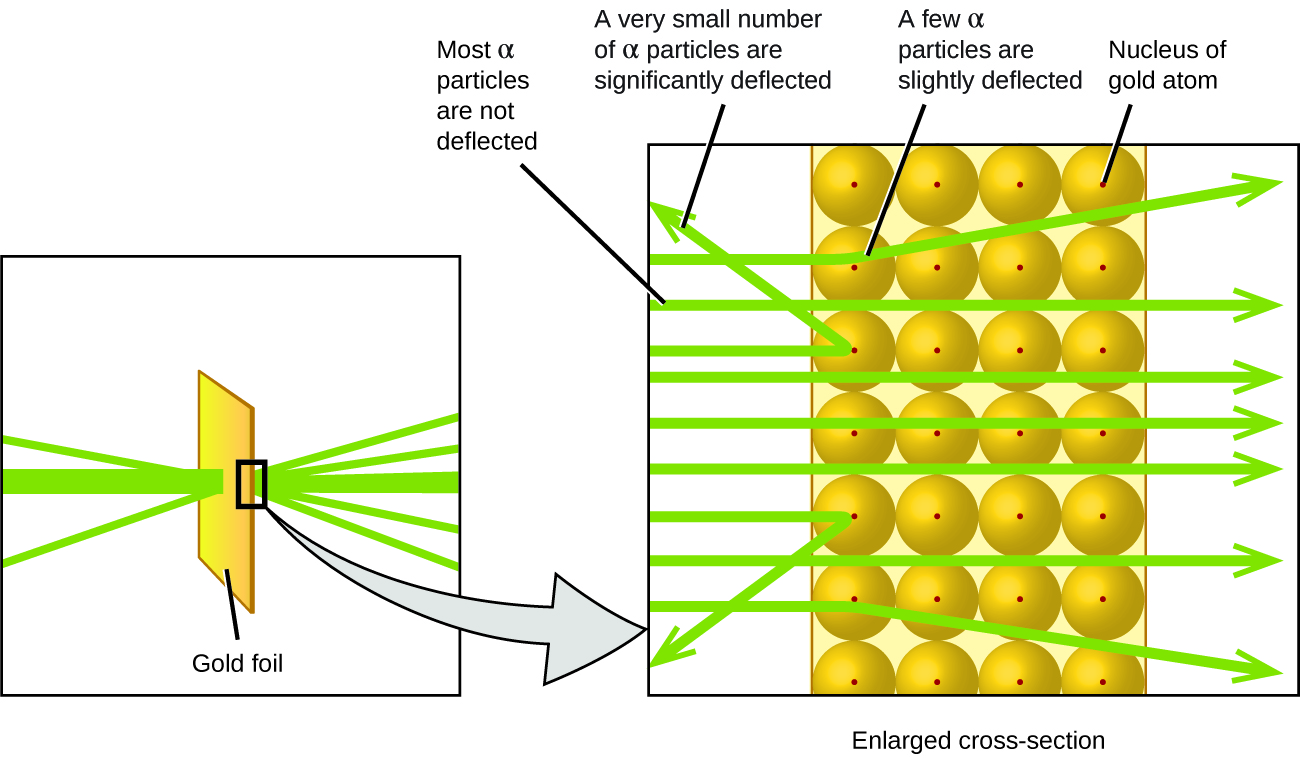7 2.2 Beyond Dalton’s Atomic Theory
Learning Objectives
By the end of this section, you will be able to:
- Outline milestones in the development of modern atomic theory
- Describe the three subatomic particles that compose atoms
- Define isotopes and give examples for several elements
In the two centuries since Dalton developed his ideas, scientists have made significant progress in furthering our understanding of atomic theory. Much of this came from the results of several seminal experiments that revealed the details of the internal structure of atoms.
Atomic Theory after the Nineteenth Century
An important adjustment to Dalton’s Theory: atoms are divisible
If matter were composed of atoms, what were atoms composed of? Were they the smallest particles, or was there something smaller? In the late 1800s, a number of scientists interested in questions like these investigated the electrical discharges that could be produced in low-pressure gases, with the most significant discovery made by English physicist J. J. Thomson using a cathode ray tube. This apparatus consisted of a sealed glass tube from which almost all the air had been removed; the tube contained two metal electrodes. When high voltage was applied across the electrodes, a visible beam called a cathode ray appeared between them. This beam was deflected toward the positive charge and away from the negative charge, and was produced in the same way with identical properties when different metals were used for the electrodes. In similar experiments, the ray was simultaneously deflected by an applied magnetic field, and measurements of the extent of deflection and the magnetic field strength allowed Thomson to calculate the charge-to-mass ratio of the cathode ray particles. The results of these measurements indicated that these particles were much lighter than atoms (Figure 1).

Based on his observations, Thomson proposed that the particles are attracted by positive (+) charges and repelled by negative (−) charges, so they must be negatively charged (like charges repel and unlike charges attract). Furthermore, they are less massive than atoms and indistinguishable, regardless of the source material, so they must be fundamental, subatomic constituents of all atoms.
Although controversial at the time, Thomson’s idea was gradually accepted, and his cathode ray particle is what we now call an electron, a negatively charged, subatomic particle with a mass approximately two thousands that of a hydrogen atom. The term “electron” was coined in 1891 by Irish physicist George Stoney, from “electric ion.”
The nucleus and the proton
In 1909, more information about the electron was uncovered by American physicist Robert A. Millikan via his “oil drop” experiments. Millikan created microscopic oil droplets, which could be electrically charged by friction, set to drop due to gravity, and then slowed or even reversed by an applied electric field lower in the apparatus. By adjusting the electric field strength and making careful measurements and appropriate calculations, Millikan was able to determine the charge on individual drops (Figure 2), and figure out the charge on individual electrons. Further work with charge to mass ratios allowed him to determine the mass of the electron as well.
Scientists had now established that the atom was not indivisible as Dalton had believed.
But the structure of the atom was otherwise not well understood. Where did these electrons reside? And what about the positively-charged portions of the atoms that also must exist to counterbalance the negative electron charge?
In 1904, Thomson proposed the “plum pudding” model of atoms, which described a positively charged mass with an equal amount of negative charge in the form of electrons embedded in it, since all atoms are electrically neutral. A competing model had been proposed in 1903 by Hantaro Nagaoka, who postulated a Saturn-like atom, consisting of a positively charged sphere surrounded by a halo of electrons (Figure 3).

The next major development came from experiments led by Ernest Rutherford. He and his colleagues performed a series of experiments using high-speed, positively charged alpha particles (α particles) produced by the radioactive decay of radium. They aimed a beam of α particles at a very thin piece of gold foil and examined the resultant scattering of the α particles using a special screen that glowed briefly where hit by an α particle.
Most alpha particles passed right through the foil. However, some were diverted slightly, and a very small number were deflected almost straight back toward the source (Figure 4). Rutherford described finding these results: “It was quite the most incredible event that has ever happened to me in my life. It was almost as incredible as if you fired a 15-inch shell at a piece of tissue paper and it came back and hit you”[1] (p. 68).

Here is what Rutherford deduced: Because most of the fast-moving α particles passed through the gold atoms undeflected, they must have traveled through essentially empty space inside the atom. Alpha particles are positively charged, so deflections arose when they encountered another positive charge and were repelled by it. The few positively charged α particles that changed paths abruptly must have hit, or closely approached, another body that also had a highly concentrated, positive charge. Since the deflections occurred a small fraction of the time, this charge only occupied a small amount of the space in the gold foil. Analyzing a series of such experiments in detail, Rutherford drew two conclusions:
- The volume occupied by an atom must consist of a large amount of empty space.
- A small, relatively heavy, positively charged body, the nucleus, must be at the center of each atom.

View this simulation of the Rutherford gold foil experiment. Adjust the slit width to produce a narrower or broader beam of α particles to see how that affects the scattering pattern.
This analysis led Rutherford to propose a model in which an atom consists of a very small, positively charged nucleus, in which most of the mass of the atom is concentrated, surrounded by the negatively charged electrons, so that the atom is electrically neutral (Figure 5). After many more experiments, Rutherford also discovered and named the proton, the positively charged, subatomic particle found in the nucleus.


The Rutherford Scattering simulation allows you to investigate the differences between a “plum pudding” atom and a Rutherford atom by firing α particles at each type of atom.
Neutrons and isotopes
During the early 1900s, scientists identified several substances that appeared to be new elements, isolating them from radioactive ores. For example, a “new element” produced by the radioactive decay of thorium was initially given the name mesothorium. However, a more detailed analysis showed that mesothorium was chemically identical to radium (another decay product), despite having a different atomic mass. This result, along with similar findings for other elements, led the English chemist Frederick Soddy to realize that an element could have types of atoms with different masses that were chemically indistinguishable. These different types are called isotopes—atoms of the same element that differ in mass. Soddy was awarded the Nobel Prize in Chemistry in 1921 for this discovery.
One puzzle remained: The nucleus was known to contain almost all of the mass of an atom, with the number of protons only providing half, or less, of that mass. Different proposals were made to explain what constituted the remaining mass, including the existence of neutral particles in the nucleus. As you might expect, detecting uncharged particles is very challenging, and it was not until 1932 that James Chadwick found evidence of neutrons, uncharged, subatomic particles with a mass approximately the same as that of protons. The existence of the neutron also explained isotopes: They differ in mass because they have different numbers of neutrons, but they are chemically identical because they have the same number of protons.
Electrons
In the early 20th century several lines of thinking led to the development of the field of quantum mechanics. A combination of experimental and theoretical approaches sharpened understandings about atomic structure, particularly with respect to electrons. Because the mathematical underpinnings of quantum mechanics is difficult and the concepts are foreign to our daily experiences, the descriptions of electronic structure have not become familiar to most people.
However elements of the quantum mechanical description of atomic structure are very helpful in understanding chemistry.
Consider these basic questions: Where do electrons exist in an atom? Do they travel? Quantum mechanics offers some explanation, but those explanations are not easy to understand and rely on advanced mathematics. Instead of attempting to understand it deeply, we can rely on simply adopting mental models that are easier to understand and that are aligned with quantum mechanical descriptions. As long as we recognize the limits of our models, that they are simplifications and not fully descriptive of real atoms, we will be able to explain a lot of chemistry with them.
Quantum mechanics suggests electrons exist in distinct regions at set distances from the nucleus. These regions are called “shells.” Each shell has a limited capacity, that varies. The innermost shell has a capacity of 2 electrons, for instance. Electrons that are part of an atom occupy shells from the innermost one outward, generally filling each to capacity before occupying the next shell out.
Electrons can move from one shell to another, including moving outward into otherwise unoccupied shells. It takes energy to make these transitions, which we refer to as excited states. Electrons falling back from those states into their closer shells are said to move toward the ground state. Transitions to excited states require input energy; transitions back to or toward the ground state can release it. The energy absorbed or released in these processes can be visible light, which means that such transitions can be visible.
Experimental study of atoms and their energy transitions has provided evidence to support the models of electron shells. The patterns of energy transitions can also be used to identify the presence of elements in a sample, by measuring the wavelengths of emitted light and comparing the pattern to known elements. These emission spectra have been a valuable tool to the science of astronomy, as we evaluate emitted light from stars to determine their composition.
As we begin to consider chemical bonding and reactions, the electronic structure of atoms will be important. This is because almost all chemical behavior involves these electrons, particularly those that exist in the outermost shell of an atom: the shell referred to as the valence shell.
Key Concepts and Summary
Although no one has actually seen the inside of an atom, experiments have revealed much about atomic structure. Atoms contain small, negatively charged particles called electrons. They have a small, dense, positively charged nucleus; the positively charged particles within the nucleus are called protons. The nucleus also contains neutral particles called neutrons. Atoms of the same element can differ in mass; these are called isotopes. Electrons are distributed into shells surrounding the nucleus. Shells have limited capacities, and electrons fill them from the innermost shell outward. However transitions from inner to outer shells can occur if energy is absorbed by an atom. Electrons in valence shells are particularly important because they are involved in chemical bonding and reactivity. All of these understandings are supported by experiments, providing a solid foundation of chemistry at the microscopic scale.
Review-Refresh, Extend
Review-Refresh
1. The existence of isotopes violates one of the original ideas of Dalton’s atomic theory. Which one?
2. Predict and test the behavior of α particles fired at a plum pudding (Rutherford model) atom. If atoms were constructed this way, what would the data show?
Now test your predictions. Open the Rutherford Scattering simulation and select the “Rutherford Atom” tab. Due to the scale of the simulation, it is best to start with a small nucleus, so select “20” for both protons and neutrons, “min” for energy, show traces, and then start firing α particles. Does this match your prediction? If not, explain why the actual path would be that shown in the simulation.
Extend
- When you imagine an atom, what do you see in your mind’s eye? Take a few minutes to sketch out an atom, using your current understandings. What do you feel confident you know about this structure? What are you unsure of? Where do you believe your representation is wrong?
- Use the simulation to experiment further, changing other parameters such as the mass of the atoms in the foil (use something other than gold). Do your results seem consistent with the mental model of an atom you have in your mind?
- When experimental results surprise scientists, what do they need to do to respond to those surprising results? How does this process help science progress?
Answers to Review-Refresh
1. Dalton originally thought that all atoms of a particular element had identical properties, including mass. Thus, the concept of isotopes, in which an element has different masses, was a violation of the original idea. To account for the existence of isotopes, the second postulate of his atomic theory was modified to state that atoms of the same element must have identical chemical properties.
2. a) The Rutherford atom has a small, positively charged nucleus, so most α particles will pass through empty space far from the nucleus and be undeflected. Those α particles that pass near the nucleus will be deflected from their paths due to positive-positive repulsion. The more directly toward the nucleus the α particles are headed, the larger the deflection angle will be.
Glossary
alpha particle (α particle): positively charged particle consisting of two protons and two neutrons
electron: negatively charged, subatomic particle of relatively low mass located outside the nucleus
isotopes: atoms that contain the same number of protons but different numbers of neutrons
neutron: uncharged, subatomic particle located in the nucleus
nucleus: massive, positively charged center of an atom made up of protons and neutrons
proton: positively charged, subatomic particle located in the nucleus
- Ernest Rutherford, “The Development of the Theory of Atomic Structure,” ed. J. A. Ratcliffe, in Background to Modern Science, eds. Joseph Needham and Walter Pagel, (Cambridge, UK: Cambridge University Press, 1938), 61–74. Accessed September 22, 2014, https://ia600508.us.archive.org/3/items/backgroundtomode032734mbp/backgroundtomode032734mbp.pdf. ↵

